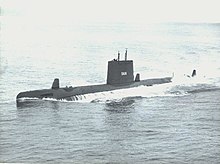Passive Underwater Fire Control Feasibility System


Passive Underwater Fire Control Feasibility System (or Study) (PUFFS) was a passive sonar system for submarines. It was designated AN/BQG-4 and was primarily equipped on United States Navy conventional submarines converted to GUPPY III or otherwise modernized in the 1960s. It was also equipped on the nuclear-powered USS Tullibee (SSN-597). A version known as "Micropuffs" was fitted on Oberon-class submarines for the Royal Australian Navy, and as Type 2041 on the Upholder-class for the British Royal Navy. This class still serves in the Royal Canadian Navy, where Micropuffs is known as BQG-501.[1] The system was notable for three tall, fin-like domes topside, except on Micropuffs installations. The system was retained on several submarines transferred to foreign navies. It was associated with long-range passive detection of targets for the Mark 45 nuclear torpedo and other torpedoes as well. Most submarines backfitted with it were also lengthened 12-16 feet to accommodate additional electronics and plotting rooms. It was also planned for Thresher and Sturgeon-class nuclear submarines, but was not fitted on them except Micropuffs experimentally on Barb and Haddock.[2] With the exception of the four Canadian Victoria-class submarines, all PUFFS-equipped submarines have been disposed of or preserved as museum ships.
See also
References
- ^ Friedman, p. 246
- ^ Friedman, Norman (1995). U.S. Submarines Through 1945: An Illustrated Design History. Annapolis, Maryland: United States Naval Institute. pp. 16–17, 43. ISBN 1-55750-263-3.
- Alden, John D., Commander (USN Ret) (1979). The Fleet Submarine in the U.S. Navy: A Design and Construction History. London: Arms and Armour Press. ISBN 0-85368-203-8.
{{cite book}}: CS1 maint: multiple names: authors list (link) CS1 maint: ref duplicates default (link) - Sub vs Sub, Cdr R Compton Hall, Orion Books, 1989
